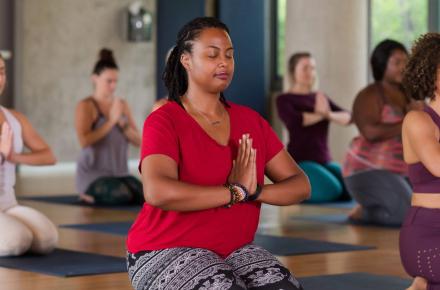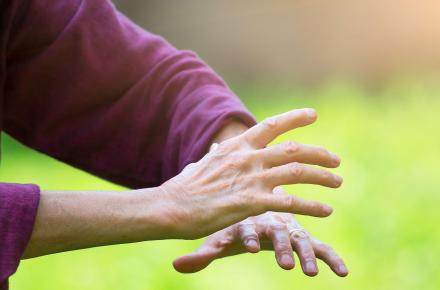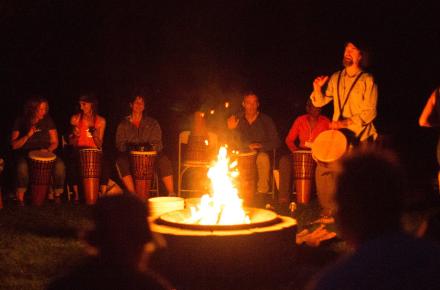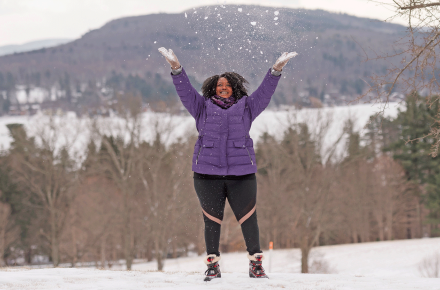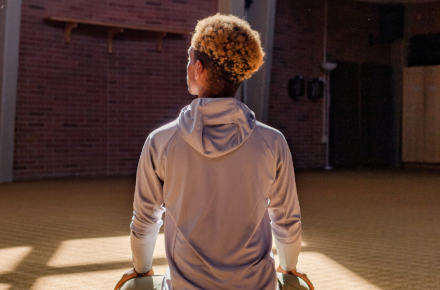Yoga Is for Everybody


It’s 4:30 in the morning, an auspicious time for angels, gods, and yoga practitioners who are doing morning sadhana. We are all different shapes and sizes, and we are all black. To my right is a sister with a tight body, small waist, ample hips, and very long legs; behind me sits a man who is over six feet tall with long legs and a strong back. I sit in between these two with what I like to refer to as my zaftig shape—ample in hip, thigh, and buttocks. Another student joins us, and his slender frame claims a space in the back of the room. We are all here for sadhana—small, tall, strong, long, lean, ample, slender, and zaftig. Although our shapes and sizes are different, we share the practice of yoga.
If an observer looked into the room, they would see that my Chair pose is different from the man to my right, with his razor-quick movement into and out of the posture reflecting his youth, agility, and strength. A woman to the right of me appears unsteady. When we lower ourselves to the floor for Shoulderstand, she moves close to a wall and presses her feet into the wall, raising her hips and buttocks into her personal expression of Shoulderstand. Who is right? Who is wrong? No one is wrong or right. We are all practicing hatha yoga as it should be. Each of our unique interpretations of these asanas fills the room with breath and movement as we intuitively create our personal yoga palette.
I have read the sacred yogic texts, the Hatha Yoga Pradipika and the Yoga Sutras of Patanjali; there is no mention of an ideal type of yoga practitioner within these texts. My studies have also led me to contemporary works by twentieth- and twenty-first-century yoga scholars and teachers such as T.K.V. Desikachar, Pattabhi Jois, B.K.S. Iyengar, Georg Feuerstein, and Stephen Cope, and none of these respected writings indicate that there is an ideal shape, size, color, age, or health status for a yoga practitioner. According to Patanjali, yoga happens when we practice asana with sthira-sukha, or steadiness and comfort, but he does not indicate that there is a perfect way any of the yoga postures "should" look. (Patanjali's Yoga Sutras are one of the six darshanas of the Vedic schools, and stands alongside the Bhagavad Gita and Hatha Yoga Pradipika to delineate and define yoga. Written almost 2,000 years ago, the Yoga Sutras remains one of the most influential works on yoga, as relevant today as when it was written.)
How one looks, how one moves, one’s lifestyle, health, or how one performs the asanas has little to do with the true practice of yoga. Yoga is the process of learning to be aware of self and others, finding an authentic, natural way to move your body. Yoga is balance and flexibility; yoga is breath; yoga is connecting the breath to the movement; yoga is living in the present moment with mindfulness; yoga is increasing the flow of energy (prana); yoga is stilling the myriad fluctuations of the mind and ultimately achieving bliss.
As a Kripalu Yoga teacher, I have worked with all kinds of people. When Jeannie came to hear me speak about yoga at the Multiple Sclerosis Society, she was seated in a wheelchair. After my lecture, she stayed for the class and worked with a partner as I demonstrated easy chair postures. A week later, Jeannie called me and revealed that, in addition to MS, she was also suffering from severe depression (understandable given her diminishing mobility), and she wondered if the practice of yoga might help her. She made an initial appointment for a private yoga session and chose to study asana, breathing (pranayama), and meditation with me for the next two years. Although she never recovered physically, yoga helped her renew her connection to her self and her spirit. After the two years, she decided to use her considerable savings and insurance to travel the world. The last time I heard from Jeannie, she was still practicing yoga and living in Hawaii.
John weighed more than 300 pounds when he came to my class; clearly he was not your regular practitioner, yet he wanted to practice yoga. He had wanted to practice for a long time but never found a class where he felt comfortable. This day, I was particularly proud of my not-so-typical body, because it had encouraged John to find his way onto the path. John attended a weekly yoga class that I offered and, over time, I watched as he became aware of his body. At first, he struggled with the postures while seated in a chair, then while standing tentatively in back of a chair, and finally on his own two feet and onto the yoga mat. Once he made the connection to his body, John was able to keep his commitment to losing weight, which he did successfully.
A couple of years ago, I needed some work done in my house, and a good friend recommended a local painter. When he arrived at my door, I saw a thin, sickly looking man. If it were not that my friend had recommended him and I trusted her, I would not have let him into my home to do anything. When he started working, I understood why my friend had recommended him; it was clear that he was an artist with a paintbrush. At the end of the day, I asked him to get ready to close up shop as my yoga class was scheduled to begin within the hour. I wanted to sage my yoga room and get the energy right. As he prepared to leave, he turned to me and asked if he might come back and take the yoga class. Without hesitation, I said yes. It turned out that he was a heroin addict, but he was also intent upon learning yoga. Today, he is drug free, and is a certified yoga teacher who works with incarcerated youth and lives full-time in an ashram.
None of these folks or their stories would normally appear in a yoga calendar or in the pages of our popular yoga books, nor would they appear on the cover of contemporary yoga magazines, but clearly they make the argument that yoga is for everyone.
It does not matter whether or not one is physically fit, short, tall, fat, thin, aware, unaware, flexible or inflexible, willing or not willing. Yoga is a practice that opens its arms to all. It doesn’t matter where you come from, how you were raised, what you own or don’t own; yoga is an invitation to celebrate your own experience.

























